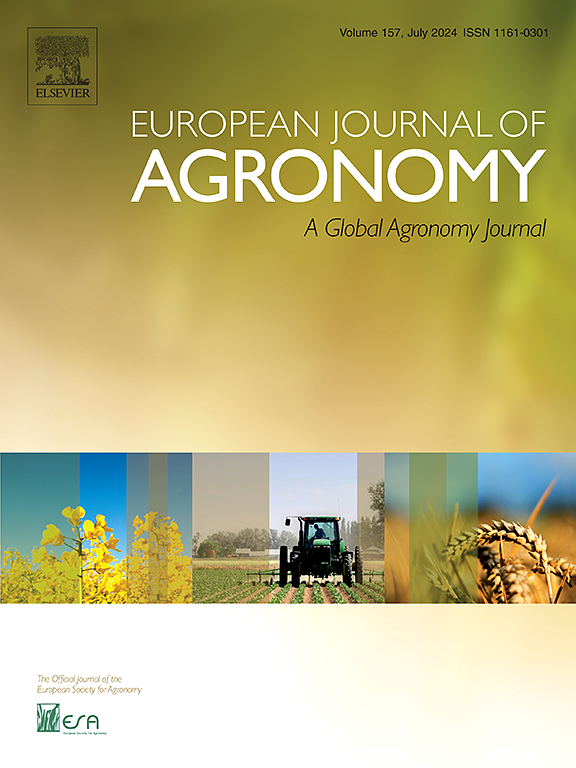西非加纳含硫和含锌肥料对大豆产量的影响及空间和季节变化分析
IF 5.5
1区 农林科学
Q1 AGRONOMY
引用次数: 0
摘要
大豆[甘氨酸max (L.)]稳定。是加纳的一种重要作物。然而,整个季节和空间的产量变化限制了其改善农民生活的潜力。本文章由计算机程序翻译,如有差异,请以英文原文为准。
Effect of sulfur- and zinc-containing fertilizers on soybean yield and analysis of spatial and seasonal yield variability in Ghana, West Africa
Context
Soybean [Glycine max (L.) Merr.] is an important crop in Ghana. However, the variability of yields throughout the season and in space limits its potential to improve the lives of farmers.
Objective
A two-year study was conducted in eight regions of Ghana from 2020 to 2021 to evaluate the effect of 10 fertilization strategies that combined nitrogen (N; 0, 18 kg ha−1), phosphorus (P; 0, 20 kg ha−1), potassium (K; 0, 25 kg ha−1), sulfur (S; 0, 10 kg ha−1), zinc (Zn; 0, 2.5 kg ha−1), and inoculant (I; Bradyrhizobium diazoefficiens) – NPS_I, PK_I, NPKS_I, PKS_I, NPKZn_I, PS_I, NPK, NKS_I, NPK_I, and control. The study also characterized the factors driving the spatial and temporal variability of yield.
Methods
Randomize complete block design was used to set up experiments in eight regions. The effects of the fertilizer treatments were analyzed using a linear mixed effects model, and a conditional random forest model was employed to predict yield spatially and seasonally, with the objective of characterizing the effect sizes of biophysical variables on yields.
Results
In 2020, the highest average yield was achieved through the additive effect of NPS_I, which resulted in an increase in yield of 381 kg ha−1 over the control yield and 217 kg ha−1 over the NPK_I treatment. Similarly, in 2021, NPS_I significantly increased yield by 261 kg ha−1, although the highest average yield increase of 516 kg ha−1 was achieved through the additive effect of NPKZn_I relative to the control yield. The yield’s coefficient of variation was significant in both years at ∼50 %. The random forest model only accounted for 20–24 % of the yield variability and predicted that the partial yield gain ranged from 7 kg ha−1 to 70 kg ha−1 with S and 14 kg ha−1 to 26 kg ha−1 with P. Increasing solar radiation and minimum temperature resulted in average yield losses of 35 kg ha−1 and 71 kg ha−1 respectively. Conversely, increasing the depth of the soil root zone and pH contributed to yield increases of 35 kg ha−1 and 73 kg ha−1, respectively.
Conclusion and significance
The results imply that the use of S in combination with P is an effective strategy for increasing soybean yields in Ghana. Spatial and temporal yield prediction maps indicate that soybean yield gain can increase significantly with fertilizer application in the northern part of the country, a stronghold of soybean production, but this depends on the growing period. Our study provides valuable information on the contribution of climatic and soil variables to soybean yield variability and recommends the use of S in combination with NPK for soybean planting in the month of May in Ghana.
求助全文
通过发布文献求助,成功后即可免费获取论文全文。
去求助
来源期刊

European Journal of Agronomy
农林科学-农艺学
CiteScore
8.30
自引率
7.70%
发文量
187
审稿时长
4.5 months
期刊介绍:
The European Journal of Agronomy, the official journal of the European Society for Agronomy, publishes original research papers reporting experimental and theoretical contributions to field-based agronomy and crop science. The journal will consider research at the field level for agricultural, horticultural and tree crops, that uses comprehensive and explanatory approaches. The EJA covers the following topics:
crop physiology
crop production and management including irrigation, fertilization and soil management
agroclimatology and modelling
plant-soil relationships
crop quality and post-harvest physiology
farming and cropping systems
agroecosystems and the environment
crop-weed interactions and management
organic farming
horticultural crops
papers from the European Society for Agronomy bi-annual meetings
In determining the suitability of submitted articles for publication, particular scrutiny is placed on the degree of novelty and significance of the research and the extent to which it adds to existing knowledge in agronomy.
 求助内容:
求助内容: 应助结果提醒方式:
应助结果提醒方式:


